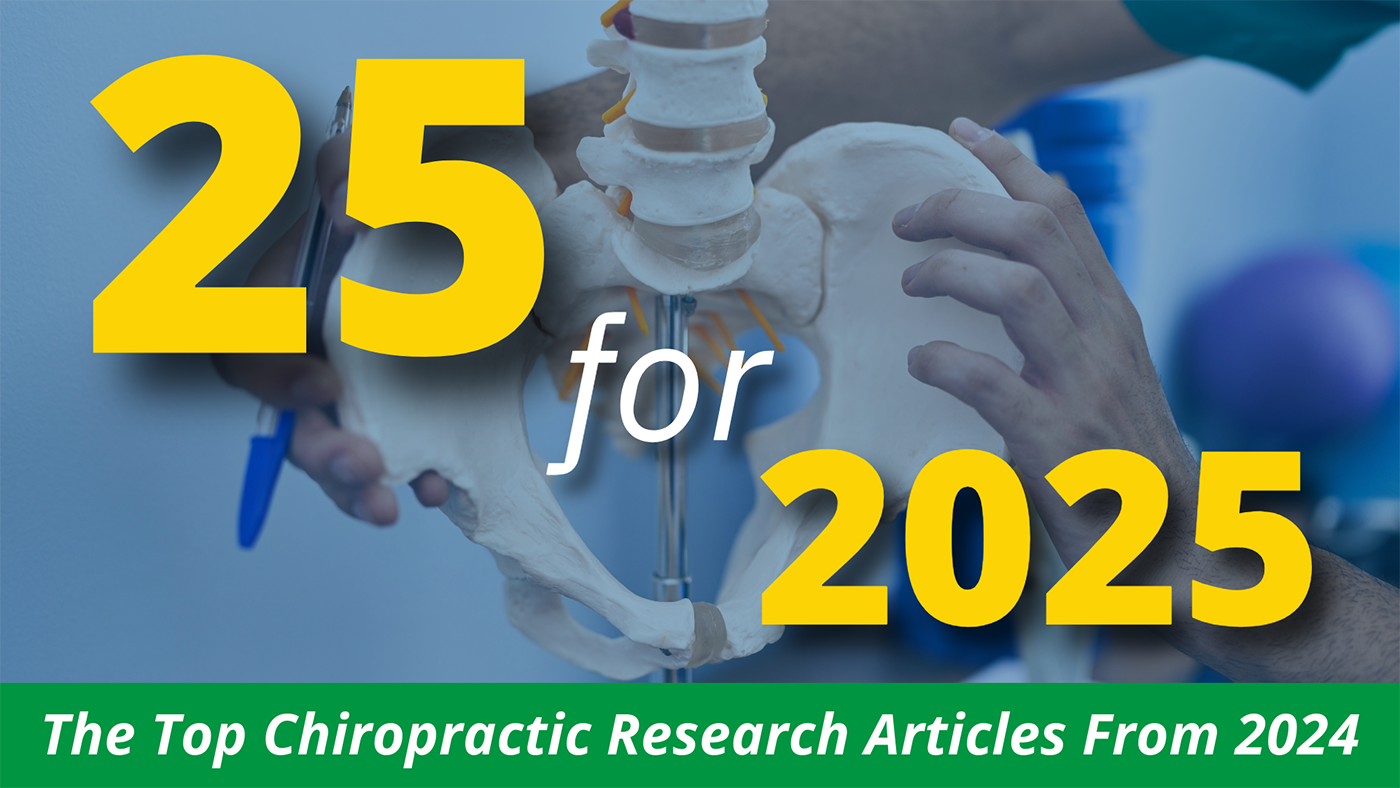By ANJC Board Member Dr. David Graber
Welcome to our annual selection of some of the most useful research studies for the practicing chiropractor!
I am proud to report that 2024 saw a propensity of articles relating directly to chiropractic care and especially spinal manipulation (SM). Therefore, this year, we are focusing on the topics of SM and chiropractic adjustments.
Without further delay, here they are!
1. Do Audible Sounds during a Lumbar Spine Thrust Manipulation Have an Impact on Brainwave Activity?
The lack of brainwave response differences between the audible and non-audible groups implies no direct, measurable placebo or beneficial effect from the audible sound. This study could not identify a benefit from the audible sound during an HVLA manipulation of the subjects.
Takeaway: The effectiveness of SM does not depend on producing an audible sound.
2. Comparison of Short-Term Effects of Different Spinal Manipulations in Patients with Chronic Non-Specific Neck Pain: A Randomized Controlled Trial
A combination of manipulations in the cervical, cervicothoracic junction, and thoracic spine results in a slightly more pronounced decrease in self-perceived disability compared to upper cervical spine manipulations in patients with chronic non-specific neck pain one-week post-intervention. However, no statistically significant differences were observed between the groups in terms of pain intensity or cervical range of motion (CROM).
Takeaway: The lack of an improvement in CROM and the reduction in pain intensity in both groups suggest that this effect may be more closely linked to the neurophysiological and contextual aspects of spinal manipulation than its mechanical effects.
3. Adverse Events After Cervical Spinal Manipulation – A Systematic Review and Meta-Analysis of Randomized Clinical Trials
Takeaway: HVLA manipulation does not impose an increased risk of mild or moderate AEs compared to control groups.
4. Chiropractic Spinal Manipulation and Fall Risk in Older Adults with Spinal Pain: Observational Findings From a Matched Retrospective Cohort Study
Conclusions: The findings, representing the largest study to date on SMT and falls, suggest a potential reduction in fall risk after SMT in older adults with spinal pain over 13 months of follow-up compared to matched controls.
Takeaway: SMT has been shown to reduce pain and enhance stability and coordination in individuals. This may explain the decreased fall risk in older adults.
5. Effects of High-Velocity Spinal Manipulation on Quality of Life, Pain and Spinal Curvature in Children with Idiopathic Scoliosis: A Systematic Review
The results indicated the idiopathic scoliosis (IS) patients had moderate improvements in mobility, the Cobb angle, and limited improvements in quality of life with SM in combination with other therapies. SM was shown to have significant effects on reducing pain in these patients. However, there were few studies and the quality of the studies were low.
Takeaway: SM for children with IS reduces IS-related pain and improves mobility and function. As part of a multi-modal approach it can also improve their spinal curvature and enhance their quality of life.
6. Neuroplastic Responses to Chiropractic Care: Broad Impacts on Pain, Mood, Sleep, and Quality of Life
This study evaluated the underlying neurophysiological mechanisms of chiropractic care using a multifaceted approach, recording behavioral, subjective, and neurophysiological data. Measures used included: resting electroencephalography (EEG), somatosensory evoked potentials (SEPs), clinical health assessments (Fitbit), and Patient-reported Outcomes Measurement Information System (PROMIS-29). The findings revealed: a significant improvement in light sleep stage length within the chiropractic care group throughout the 4-week intervention. There was also a significant increase in clinically meaningful improvements among chiropractic care participants in anxiety, depression, fatigue, as well as decreases in pain intensity, and pain interference.
Takeaway: These findings indicate that many health benefits of chiropractic care are due to altered brain activity. The article goes in-depth on the potential mechanisms involved.
7. Chiropractic Care of Children from Birth to Adolescence and Classification of Reported Conditions: An Internet Cross-Sectional Survey of 956 European Chiropractors
Conclusion: This study showed that European chiropractors are active in the care of pediatric patients. Reported conditions were mainly skeletal and neurologic complaints. In this survey, no severe negative side effects (NSE) were reported, and mild NSEs were infrequent.
Takeaway: Pediatric chiropractic care is safe and common.
8. Strain of the vertebral artery during passive neck movements and spinal manipulation of the cervical spine: An observational study
Passive range of motion testing produced strains in the vertebral artery were 5.3 times (C0–C1), 7.2 times (C1–C2), and 3.7 times (C2–C3) greater than the corresponding strains during chiropractic spinal manipulation, suggesting that strains in the vertebral artery during chiropractic spinal manipulation were much smaller than the strains that can occur during normal everyday movements of the head and neck. Furthermore, vertebral artery strains in the pre-manipulative phase did not contribute to the peak strains on the contralateral vertebral artery and helped reduce strains on the ipsilateral side.
Takeaway: ROM testing of the cervical spine and normal movements of the neck put much more strain on the vertebral artery than a properly applied chiropractic adjustment to the cervical spine.
9. The effect of a spinal thrust manipulation’s audible pop on brain wave activity: a quasi-experimental repeated measure design
The audible sounds caused by a thoracic high-velocity thrust manipulation did not affect the activity in the audible centers in the temporal brain region. The results support the hypothesis that thrust manipulation with or without audible sound results in a generalized relaxation immediately following the manipulation. The absence of a significant difference in brainwave activity in the frontal lobe in this study might indicate that the audible pop does not produce a “placebo” mechanism.
Takeaway: SM that produces an audible pop appear to produce more effects than those that do not.
10. Chiropractic spinal manipulation and likelihood of tramadol prescription in adults with radicular low back pain: a retrospective cohort study using US data
This study found that US adults initially receiving CSM for radicular LBP had a reduced likelihood of receiving a tramadol prescription over 1-year follow-up. These findings should be corroborated by a prospective study to minimize residual confounding.
Takeaway: Patients receiving initial (first contact) CSM for radicular LBP could reduce the likelihood of tramadol prescription either via direct pain relief mechanisms or due to entry into a non-pharmacological care pathway.
11. Association Between Spinal Manipulation, Butalbital Prescription, and Medication Overuse Headache in Adults With Tension-Type Headache: Retrospective Cohort Study
Adults receiving chiropractic SMT had a significantly lower likelihood of butalbital prescription and, tentatively, Medication Overuse Headache (MOH) compared to matched controls not receiving SMT. These findings support current guideline recommendations favoring SMT in Tension-Type Headache (TTH) care, though future studies should replicate and compare these findings with other nonpharmacologic clinicians and interventions.
Takeaway: TTH patients receiving chiropractic SMT may have a significant reduction in the likelihood of both butalbital prescription and MOH.
12. Investigating the effects of chiropractic care on resting-state EEG of MCI patients
Mild cognitive impairment (MCI) is a stage between health and dementia, with various symptoms including memory, language, and visuospatial impairment. A comparison of the results obtained from chiropractic intervention and previous studies shows that chiropractic intervention can have a positive effect on MCI disease and may even reduce the risk of developing Alzheimer’s disease(AD) or the progression of cognitive impairment, but far more research is needed to define this relationship.
Takeaway: These results suggest that chiropractic SM intervention may augment cognitive function in people with MCI.
13. Brain plasticity following lumbar disc herniation treatment with spinal manipulation therapy based on resting-state functional magnetic resonance imaging
This study identified abnormal spontaneous brain activity and functional connectivity changes in multiple frequency bands among patients with lumbar disc herniation (LDH), demonstrated the therapeutic effects of SMT to significantly reduce pain, improve dysfunction, and partially normalize abnormal regional homogeneity and functional connections in patients with LDH.
Takeaway: This study offers preliminary clinical evidence to indicate the impact of SMT on brain activity
14. Symptoms of Patients With Vertebral Artery Dissection Presenting to Chiropractors: A Systematic Review and Meta-Analysis
The results of this meta-analysis offer tentative support for the hypothesis that patients visiting a chiropractor with undiagnosed VAD have a higher prevalence of neck pain and/or headache compared to dizziness or other symptoms. The findings, therefore, support the notion that patients experiencing symptoms related to evolving VAD may inadvertently visit a chiropractor due to concurrent neck pain and/or headache, potentially confounding the association between CSM and VAD.
Takeaway: Same
15. Dosing of lumbar spinal manipulative therapy and its association with escalated spine care: A cohort study of insurance claims
The low and moderate-dose SMT groups were associated with a significant decreased risk of any escalated spine care, as well as each intervention studied. These associations in the high-dose group were mixed: Increased risk of imaging; decreased risk of injection and ED visits; and no significant association with surgery, opioids, and any escalated spine care. For claims associated with initial episodes of low back pain, low and moderate-dose spinal manipulative therapy groups were associated with a 55% and 42% reduction, respectively, in the relative risk of any escalated spine care.
Takeaway: Patients receiving SMT have less advanced imaging, surgery, injections, and overall medical care.
16. Association between spinal manipulative therapy and lumbar spine reoperation after discectomy: a retrospective cohort study
This study found that adults experiencing lumbosacral radiculopathy at least one year after lumbar discectomy who received SMT were less likely to undergo lumbar spine reoperation compared to matched controls not receiving SMT.
Takeaway: SMT after lumbar discectomy is beneficial to patients who are still experiencing pain.
17. A randomized controlled trial comparing different sites of high-velocity, low amplitude thrust on sensorimotor integration parameters
Cervical HVLA thrust applied to the segment considered as “relevant” altered sensorimotor parameters, while cervical HVLA thrust over the segment considered as “non-relevant” did not. This finding supports the hypothesis that spinal site targeting of HVLA interventions is important when measuring neurophysiological responses.
Takeaway: Targeting the right segment for SM matters. It produces more neurological effects when applied to dysfunctional segments than non-dysfunctional ones.
18. Reduction of Chronic Primary Low Back Pain by Spinal Manipulative Therapy is Accompanied by Decreases in Segmental Mechanical Hyperalgesia and Pain Catastrophizing: A Randomized Placebo-controlled Dual-blind Mixed Experimental Trial
Spinal manipulation was more effective than a placebo for chronic back pain relief. 12 sessions were used consisting of SM in the active group, and non-SM in the control. Participant blinding was achieved, and expectations did not influence the results. Chronic low back pain patients demonstrated widespread mechanical hyperalgesia. Spinal manipulation reduced pain sensitivity at the targeted vertebral segment. Spinal manipulation reduced pain catastrophizing.
Takeaway: SM is more effective than a placebo for chronic back pain relief.
19. Cost of chiropractic versus medical management of adults with spine-related musculoskeletal pain: a systematic review
Patients with spine-related musculoskeletal pain who consulted a chiropractor as their initial provider incurred substantially decreased downstream healthcare services and associated costs, resulting in lower overall healthcare costs compared with medical management.
Takeaway: Same
20. Changes in biochemical markers following a spinal manipulation – a systematic review update
There was low-quality evidence that spinal manipulation influenced various biochemical markers. Low-quality evidence further indicated that spinal manipulation can influence inflammatory markers such as interleukins levels post-intervention. There was also very low-quality evidence that spinal manipulation does not influence substance-P, neurotensin, oxytocin, orexin-A, testosterone and epinephrine/nor-epinephrine.
Takeaway: Spinal manipulation can influence inflammatory markers and cortisol.
21. Validation of a diagnostic support tool for early recognition of cervical arterial dissection in primary care
The primary aim of this study was to determine the utility of a diagnostic support tool for identifying potential Cervical Artery Dissection (CeAD) patients within an emergency care setting and flag the need for vascular imaging. The secondary aim of this study was to refine the Index Tool and identify meaningful cut-off values for clinical use. The refined tool removed age and added the criterion of ‘unusual or unfamiliar pain’, ‘acute or sudden’ and ‘two or more neurological features’. This refined tool with four criteria: acute or sudden onset; unusual headache or neck pain; trauma/infection; and neurological features ≥2 ( sensory loss/paraesthesia, limb weakness, visual disturbance and Horner’s syndrome were the most common), and a cut-off of 3, showed good sensitivity and specificity and now needs further validation for use in an emergency setting. However, in less acute primary care settings, the age criterion may still be still relevant and should be considered.
Takeaway: The Index Tool, consisting of 4 criteria, is easy to implement into any chiropractor’s consultation and examination. It can better screen for patients with possible CeAD.
22. Effect of Chiropractic Intervention on Oculomotor and Attentional Visual Outcomes in Young Adults With Long-Term Mild Traumatic Brain Injury: A Randomized Controlled Trial
Chiropractic care in participants with persistent postconcussion syndrome (PPCS) significantly improved static and dynamic gaze stability, and performance in the Stroop test, compared with a control intervention. These results suggest that chiropractic care can offer a novel avenue for alleviating certain visual and cognitive symptoms in patients with PPCS. It also adds to the growing evidence that suggests that some longstanding PPCS visual symptoms may have a spinal or proprioceptive basis.
Takeaway: Chiropractic care may offer a novel avenue for alleviating certain visual and cognitive symptoms in patients with PPCS.
23. An Additive Effect of Instrument-Assisted Soft Tissue Mobilization with Spinal Manipulation in Cervicogenic Headache: a Randomized Controlled Trial
The study concluded that spinal manipulation (SM) accompanied with instrument assisted soft tissue mobilization provided better long-term outcomes in patients with cervicogenic headache than SM alone..
Takeaway: Same
24. Chiropractic and Spinal Manipulation: A Review of Research Trends, Evidence Gaps, and Guideline Recommendations
This narrative review of 33 Clinical Practice Guidelines over the past 50 years found that 90% favored SMT for low back pain while 100% favored SMT for neck pain. Recent CPG recommendations favored SMT for tension-type and cervicogenic headaches. There has been substantial growth in the number and quality of chiropractic research articles over the past 50 years, resulting in multiple CPG recommendations favoring SMT.
Takeaway: The findings of this comprehensive review reinforce the value and utility of SMT for spine-related disorders.
25. Restoration of normal central pain processing following manual therapy in nonspecific chronic neck pain
For patients with non-specific chronic neck pain (NSCNP) this study observed beneficial effects on conditioned pain modulation (CPM) and temporal summation of pain (TSP) responses. This support the notion that manual therapy may operate, to some extent, by influencing central pain processing to ameliorate pain and improve clinical status. Treatments consisted of articular passive mobilizations, soft tissue mobilization, and trigger point treatment performed by the clinician following clinical reasoning.
Takeaway: The effects of hands-on manual therapy are multifactorial and some may operate by influencing central pain processing.

About the Author
Dr. David Graber is a nationally known presenter on chiropractic technique and is a member of the ANJC Board of Directors. He maintains a private practice in Parsippany, NJ. He blogs on chiropractic and clinical topics at drgraber.wordpress.com, and he can be reached at DrDavidGraber@gmail.com.


0 Comments